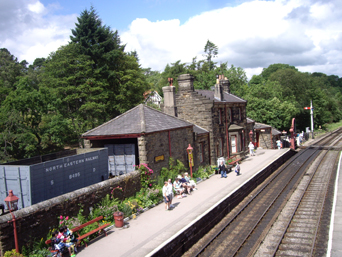Wonderful Whitby
Famous People of Whitby
The Town of Whitby has had many famous sons and daughters, over the years, and has been a host to many television and film locations. Caedmon an early English poet, formerly an Anglo Saxon herdsman, lived at Whitby Abbey, whilst the Abbess St. Hilda presided from 657 to 680 ad. He was originally ignorant of "the art of song", but learned to compose one night during a dream, according to the 8th-century monk Bede. Caedmon's only known surviving work is Caedmon's Hymn. The poem is one of the earliest examples of Old English.

Captain Cook's Museum, Grape Lane
Great Explorers such as Captain James Cook and Sir William Scoresby sailed from the Town of Whitby. Captain Cook was a British explorer, navigator and cartographer. Cook made detailed maps of Newfoundland and then went on to make three voyages to the Pacific Ocean. During these voyages he became the first European to make contact with the Eastern Coast of Australia and the Hawaiian Islands, and made the first recorded circumnavigation of New Zealand.

Grape Lane, Whitby
You can learn more about Captain James Cook in Whitby, by visiting the Captain Cook's Museum or the Pannett Park Museum, by clicking on the following link. Captain Cook Memorial Museum.

Royal Crescent, West Cliff Whitby
Whitby has been the inspiration for many an author. Bram Stoker, who stayed in Whitby on holiday, drew his inspiration for Dracula from here, and indeed the story begins in Whitby with the shipwreck of The Demeter.

The Khyber Pass, Whitby
(the yellow hotel is where Lewis Carrol stayed)
Lewis Carrol (Charles Lutwidge Dodgson), stayed in Whitby on many occasions. It is thought he drew his inspiration for his poem ‘The Walrus and the Carpenter' from the nearby village of Sandsend.

Whitby West Cliff
Charles Dickens stayed here, and at Mulgrave Castle, he dedicated his book 'Dombey and Son' to the Marchioness of Normanby who lived there. Charles Dickens friend Wilkie Collins visited the area too, upon Dickens recommendation.

Whitby harbour
Elizabeth Gaskell called the Town of Whitby by the name of Monkshaven, in her novel 'Sylvia’s Lovers'.
Robin Jarvis who wrote the book 'The Whitby Witches', based it on local folklore.
R. Swindells wrote 'Room 13' about a school trip to Whitby.

199 Steps, Whitby
Michel Faber, whose book 'One hundred and Ninety-nine Steps' was based on the Abbey steps.
'Possession, a Love Story' by A.S. Byatt has Whitby as the backdrop,
and indeed part of the filming was done in Church Street.
Mary Linskell, a local author, wrote 'Between the Heather and the Northern Sea', and
also 'The Haven under the Hill'.

St Mary's Church Whitby
( featured in Simply Red's music video)
Simply Red used the Town of Whitby as the backdrop, in the music video for the song ‘Holding Back the Years’. Catch it on u-tube. Alistair Griffin, a singer songwriter went to school in Whitby and Joanne Froggat, the award winning actress, grew up locally and still has family in Littlebeck. Frank Meadow Sutcliffe (1853 to 1941), is famous for his Victorian sepia photographs of Whitby.

Goathland Station
Many films have used Whitby as a location, these include 'Captain Jack', starring Bob Hoskins as a local man Captain Jack Lammiman, 'Possession, starring Gwyneth Paltrow and 'Shackleton, the Arctic Explorer', starring Kenneth Branagh. 'Harry Potter and the Philosopher's Stone' used Goathland Station as the location for Hogwart's School Station.
